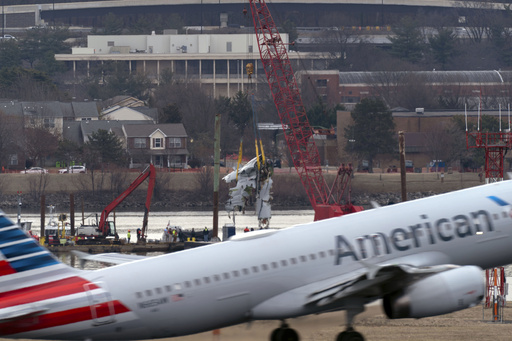
A tragic incident occurred near Washington’s Ronald Reagan National Airport nearly a week ago, when a commercial airliner collided with an Army helicopter, leading to the loss of 67 lives. This unfortunate event marks the most lethal air disaster in the United States since 2001. As teams work tirelessly to recover the wreckage from the Potomac River, investigators are relentlessly probing into the circumstances surrounding this catastrophic collision.
Here’s a comprehensive timeline detailing the key events that transpired leading up to and following the crash:
**January 29**
Around 8:15 PM, American Airlines Flight 5342, carrying 64 passengers, began its descent towards Reagan National Airport. At 8:43 PM, controllers at the airport shifted the plane’s landing from Runway 1 to Runway 33. Around the same time, an Army Black Hawk helicopter, identified as PAT25 by air traffic control, was flying south over the river under clear skies.
At 8:46 PM, the controller informed the Black Hawk crew that a passenger jet, designated as CRJ, was circling at an altitude of 1,200 feet (approximately 365 meters) for landing on Runway 33. Just a minute later, as the two aircraft closed in on each other, the controller asked the helicopter crew if they had visual contact with the CRJ. The response confirmed that the aircraft was indeed in sight, leading to a request for “visual separation,” allowing the Black Hawk to approach closer than standard operating procedures would typically allow. Controllers granted this request.
Moments later, chaos erupted in the air as audio from the incident recorded a loud disturbance followed by a bright flash, leading both aircraft to plunge into the river. Shortly after, a voice over the radio asked, “Tower, did you see that?”
In the hours that followed, search teams utilizing helicopters and inflatable boats illuminated the Potomac in hopes of finding survivors.
**January 30**
By the morning, President Donald Trump confirmed to reporters that there were no survivors and expressed uncertainty over the cause of the collision. The identities of those aboard both flights began to circulate online, appearing in tributes and heartfelt messages from mourning families.
By midday, all three soldiers from the helicopter had been identified and their bodies recovered. Meanwhile, around two miles downriver, Dean Naujoks, a representative from the Waterkeeper Alliance, discovered various debris, including pages from the flight manual, parts of the fuselage, and numerous sugar packets marked with the American Airlines logo, which were subsequently handed over to the FBI.
By evening, recovery teams had located the cockpit voice recorder and flight data recorder, which were sent for analysis.
**January 31**
As rain fell, authorities continued their search of the Potomac for victims while trying to piece together details surrounding the crash. Officials confirmed the recovery of the Black Hawk’s black box, with data under evaluation alongside the actions of the military pilot and air traffic control. Over 300 personnel were engaged on the ground throughout the day, including dive teams. By the afternoon, authorities announced that remains of 41 individuals had been retrieved.
The Army disclosed the names of two soldiers who perished: Staff Sgt. Ryan Austin O’Hara, 28, from Lilburn, Georgia, who served as the crew chief, and Chief Warrant Officer 2 Andrew Loyd Eaves, 39, from Great Mills, Maryland.
**February 1**
With the rain subsiding, a Coast Guard vessel equipped with a crane was positioned nearby as recovery teams continued their efforts in the chilly waters. During a press briefing, investigators revealed they were analyzing inconsistencies in the altitude data between the helicopter and the airplane.
They expressed hopes that insights from the helicopter’s black box would help clarify discrepancies, although its recovery was hampered due to water damage. The Army also identified the third soldier who lost their life: Capt. Rebecca M. Lobach, described by friends as “brilliant and fearless.”
**February 2**
Authorities reported the recovery of remains for 55 victims, expressing optimism that all bodies would eventually be located. As searches persisted, salvage teams prepared to start lifting aircraft debris from the Potomac.
Col. Francis B. Pera of the Army Corps of Engineers emphasized that recovery operations would adhere to strict protocols, prioritizing the respectful handling of any identified remains.
**February 3**
Today, salvage crews successfully retrieved an aircraft engine and significant sections of the fuselage while making efforts to recover a wing. Parts of both the helicopter and airplane were lifted from the water and transported to a hangar for further inquiry. Families of the victims gathered along the riverbank during this somber process.
**February 4**
As the day began, recovery teams braved rough water conditions to recover substantial sections of the airplane, including the right wing and components of the fuselage, cockpit, tail cone, and rudder. Investigators announced the examination of new data that could illuminate the altitude discrepancies noted earlier. by the end of the day, authorities confirmed that the remains of all 67 victims had been recovered, with identification for all but one individual completed.

